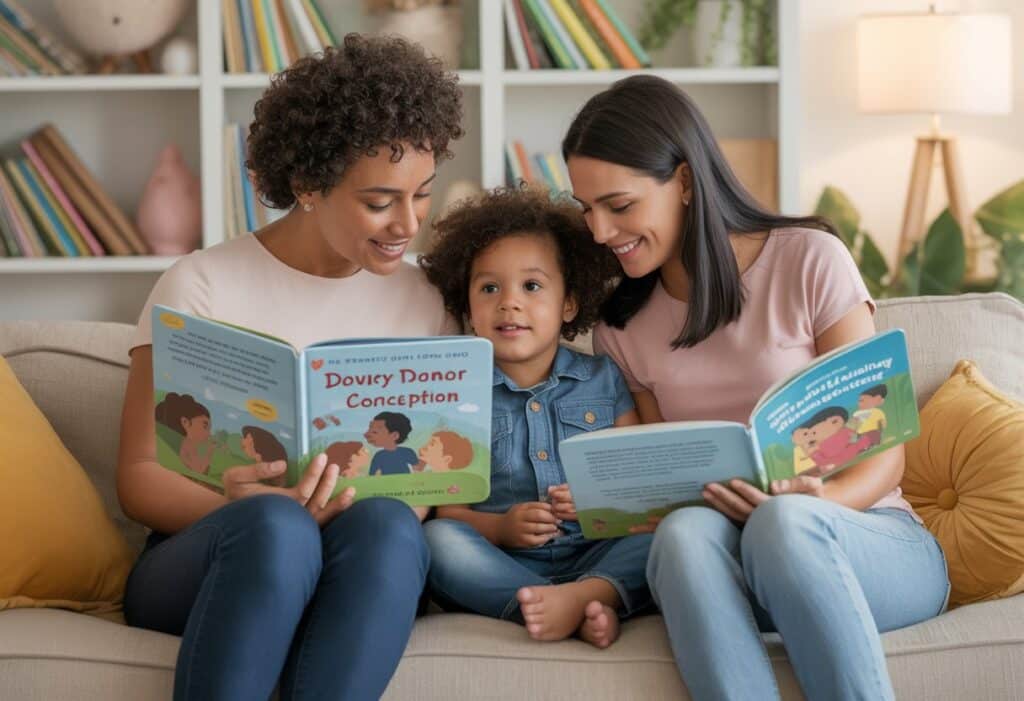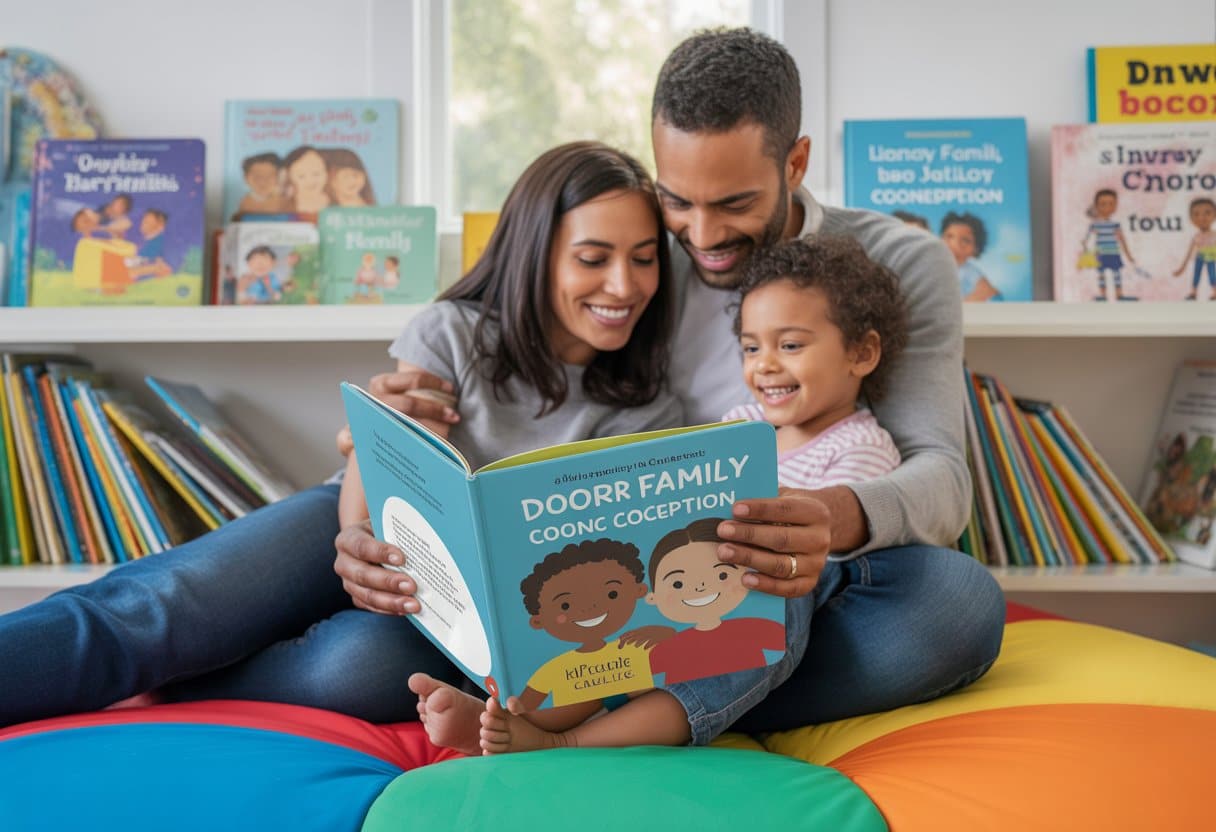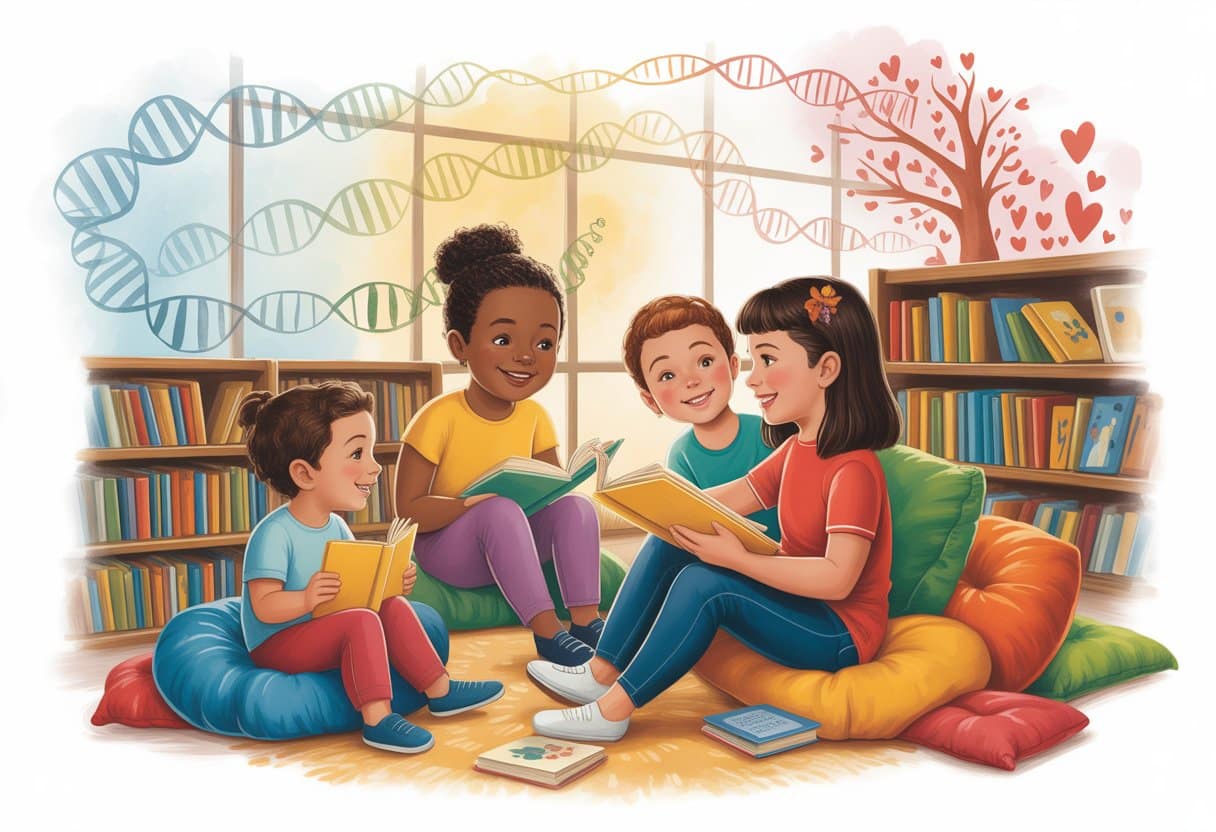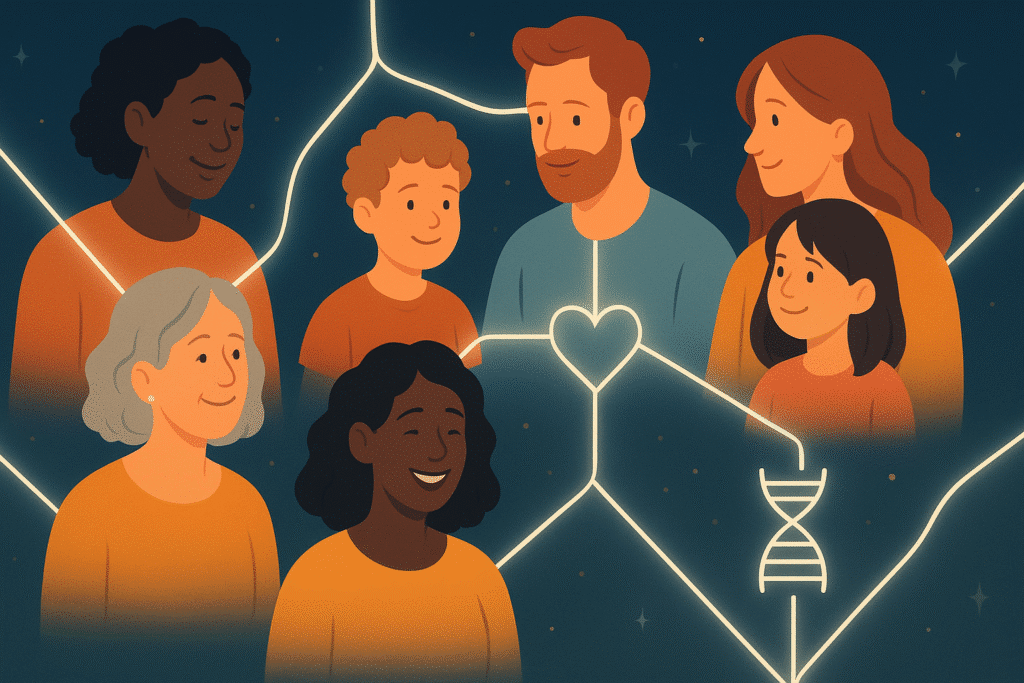Guide to Children’s Books That Explain Donor Conception: Expert Insights

Talking to kids about donor conception can feel daunting for parents. The right children’s books, though, can make these conversations feel natural and age-appropriate.
Reading carefully chosen books helps families start important conversations about how their children came to be. Simple language and relatable stories help children understand. These books, created for this purpose, become valuable tools for explaining complex family-building concepts in a way that feels ordinary, not out of the ordinary.
Modern children’s literature now offers many options for different types of donor conception. You’ll find books about egg donation, sperm donation, embryo donation, and surrogacy.
Expert guidance suggests starting these conversations early. That way, children’s understanding can grow naturally over time, instead of facing a big reveal later.
The best books for explaining donor conception come in different formats. Some let families personalise the story with their own photos and details, while others are pre-written but flexible enough for different family structures.
Whether you’re a single parent, same-sex couple, or in a more traditional partnership, you’ll find book options to help children understand their unique beginnings. These stories emphasise the love and intention behind their conception.
Understanding Donor Conception in Children’s Literature
Children’s books about donor conception play a key role for families who want to talk about complex reproductive concepts. These stories balance the emotional and factual sides of assisted reproduction with language and images that make sense to kids.
The Purpose and Importance of Explaining Donor Conception
Parents who used donor conception face unique challenges when explaining their child’s origins. Starting these conversations early helps normalise the topic and avoids tough revelations down the road.
Children’s books for donor conception offer structured narratives parents can lean on. These stories lower anxiety for both parents and kids by giving a familiar framework for tricky discussions.
When families introduce these ideas early, kids can absorb and understand them gradually. Their comprehension grows naturally, without any sudden shocks.
Fertility organisations like ASRM and RESOLVE encourage open conversations about donor conception from birth. This helps donor-conceived individuals build healthy identities, free from shame or confusion.
Books also give parents a chance to practise what they want to say. This preparation boosts confidence and keeps messaging consistent across family chats.
Key benefits include:
- Normalising donor conception processes
- Reducing anxiety for everyone
- Allowing gradual understanding
- Keeping conversations consistent
Key Concepts in Donor Conception Narratives
Great donor conception books hit on a few core themes. They help kids understand their origins by focusing on love, intention, and teamwork.
Most stories highlight how much parents wanted a child. They talk about how some families needed extra help beyond the usual way of making babies.
Books explaining donor conception use clear, simple language to introduce basic genetics. They explain how donor sperm, donor eggs, or donor embryos help create babies.
The idea of “helping” stands out in these stories. Donors show up as generous people who make parenthood possible for others.
You’ll often see:
- Parental love and intention
- The need for medical help
- Donor kindness
- Simple science explanations
- Family celebration and gratitude
Many books clarify the different types of donor conception: sperm, egg, and embryo donation. Some also talk about surrogacy when it fits the family’s story.
Role of Age-Appropriate Language
Successful donor conception books strike a balance between accuracy and what’s right for a child’s age. They use correct medical terms but keep things simple.
Recent donor conception books use words like “egg,” “sperm,” and “uterus” instead of vague terms. Kids learn the real words from the start, which honestly seems like a good thing.
Language shifts depending on the age group. Books for toddlers keep sentences short and focus on feelings—like love and wanting.
Stories for slightly older kids add more detail about fertility treatments and the challenges parents faced. They might mention IVF or lab work in easy-to-grasp terms.
Age-appropriate tips:
- Ages 2-4: Talk about love and wanting a family
- Ages 5-7: Bring in simple biology
- Ages 8-9: Explain medical procedures in basic ways
Pictures help too. Illustrations show families, medical settings, and biology in a way that feels friendly and not scary.

Overview of Family-Building Methods in Children’s Books
Children’s books about donor conception cover a range of family-building methods. Through stories and pictures, they talk about egg donation, sperm donation, embryo donation, surrogacy, IVF, and sometimes adoption.
Egg and Sperm Donation Stories
Books about egg donation usually use simple images or metaphors to show how a generous woman gave the special egg needed for a baby. These stories focus on the donor’s kindness and the parents’ deep desire for a child.
The Magic of You lets parents personalise egg donor stories for all kinds of families—single dads, gay dads, single mums, and traditional families. Families can even add details about their own donor.
Sperm donation stories explain how a kind man provided the missing piece to go with mummy’s egg. These stories work for single mums, lesbian couples, and heterosexual couples with male fertility struggles.
The Donor Conception Network series uses people in their illustrations instead of animals. They offer different versions to fit a variety of family shapes and donor conception journeys.
Most donor sperm and donor egg books stick with real words like “egg,” “sperm,” and “uterus.” This helps kids get a clear idea of how things work.
Surrogacy and Embryo Donation Explained
Surrogacy books show how another woman carried the baby when the intended mother couldn’t. They usually describe the surrogate as kind and helpful, highlighting her role in bringing families together.
Books about embryo donation explain that both the egg and sperm came from generous donors. The My Donor Story series includes embryo donation stories for different family types and uses accurate medical language.
The Very Kind Koala uses animal characters to introduce surrogacy with a gentle story about koala bears. This makes the idea easier for young children to grasp.
Double donation stories combine both egg and sperm donor elements. These books focus on the parents’ journey to find the right donors and build their much-wanted family.
IVF and Insemination (ICI and ART) Representation
Children’s books rarely focus only on IVF or insemination. Instead, they weave these treatments into broader donor conception stories.
Some books mention that doctors helped put the egg and sperm together in a special place. This covers IVF in a way that doesn’t overwhelm younger kids.
Books for children aged nine or less talk about different ART procedures through gentle stories. The spotlight stays on love and family creation, not medical details.
ICI gets less attention in kids’ books. When it does come up, the books say doctors helped place the donor sperm where it needed to go.
Adoption and Non-Genetic Family Narratives
Adoption books take a different approach. They focus on children born to one family and raised by another, highlighting the idea of chosen families and unconditional love.
Some stories talk about families created in more than one way. Kids might learn about siblings who arrived through different fertility treatments or adoption.
Books about DNA help explain genetic connections in donor-conceived families. The Secret Code Inside You makes ideas about chromosomes and genes simple for preschoolers.
Non-genetic family stories celebrate all kinds of families. They show kids that families form through love and commitment—not just biology.
Choosing and Using Books for Diverse Family Structures
Modern donor conception books need to reflect the fact that families look all sorts of ways—single parents, same-sex couples, or more traditional setups. The best resources use inclusive language and speak to the unique needs of LGBTQ+ parents and solo caregivers.
Inclusive Language for All Family Forms
The best books for diverse families avoid assuming a family structure from the start. Instead of always saying “mummy and daddy,” they use words like “parent,” “family,” or “grown-ups.”
The Magic of You series lets parents change the language to fit their family. You can edit every word to match your situation.
Look for books that offer:
- Gender-neutral pronouns for parents
- Flexible family words
- Editable text
- Multiple family scenarios in one series
The Donor Conception Network series does this by creating different versions for different family setups. They use people—never animals—to keep things realistic.
Good books also mention that family-building journeys can look very different. Some families need egg donors, some need sperm donors, and some need both.
Addressing Sexual Orientation and Gender Identity
Books for donor-conceived kids now recognise that parents’ sexual orientation and gender identity shape conception stories. Same-sex couples face different fertility needs than heterosexual couples.
For male couples: Books need to explain why both egg donation and surrogacy matter. The My Donor Story series has surrogacy stories for two dads and single dads.
For female couples: These stories focus on sperm donation and celebrate the bond between both mothers. The narrative highlights how both parents wanted and planned for their child.
Books should steer clear of assuming everyone’s heterosexual or that donor conception is odd. They shouldn’t act like families need to justify why they needed help.
Instead, the best resources present donor conception as just one of many ways to make a family. They normalise the experience and let kids know they’re not so different after all.
Representing Single and LGBTQ+ Parents
Single parents honestly face some tricky storytelling moments when talking about donor conception. Kids want to know why one person decided to become a parent alone, so books need to cover that without getting too heavy for little ones.
A lot of the best resources for single mothers just lay out sperm donation in plain, simple terms. The Pea That Was Me works for two-mum families but also comes in versions for other setups.
What really matters in single-parent books:
- Show that the parent planned for and wanted the child
- Explain the biology in simple words
- Celebrate the bond between parent and child
- Talk about family choices in a way kids get
LGBTQ+ families really benefit from books that show their families as loving and natural. Stories work best when they focus on the happiness of making a family, instead of always pointing out differences.
Books for donor-conceived children now include all sorts of families. Kids get to see themselves in these stories, which honestly feels important.
If you want kids to understand that families come in all shapes, you can mix and match different books. That way, they see that there’s no one “right” way to be a family.

Resources for Parents and Professionals
Parents can find special books and guides through fertility groups and donor conception networks. Medical societies and family-building charities also put out resources that actually help.
Recommended Titles and Authoritative Organisations
The Donor Conception Network has a solid collection of books for all kinds of families. You’ll find titles for two-dad families, solo parents, and straight couples using donor conception.
Some standout series:
- My Donor Story series explains genetics in a way kids actually get
- Hudson’s Blueprints for two-mum families
- A Special Egg covers egg donation stories
The network also offers guides for children aged 0-7 for all family types. These resources include info for straight couples, solo mums, and lesbian families using different donation routes.
The Hopeful Mama Foundation offers more book guides for parents having these conversations.
Guidance from Fertility, ART, and Donor Networks
RESOLVE gives support and educational material for fertility treatment choices. The American Society for Reproductive Medicine (ASRM) puts out clinical guidelines that shape what books professionals recommend.
Fertility clinics often keep age-appropriate books on hand. They use these to help parents talk to kids about embryo donors and fertility treatment.
The Donor Conceived Community runs book chats and Q&As for parents. It’s a nice way to get support and ideas.
Professional networks urge parents to start these chats early. They say being open about donor conception helps everyone in the family as they grow together.
Books like Building Your Family: The Complete Guide to Donor Conception cover both the medical side and the emotional stuff. They’re useful for both professionals and parents.
Frequently Asked Questions
Parents usually wonder when and how to bring up donor conception with their kids. Most experts say it’s best to start early, use age-appropriate books, and choose stories that show all kinds of families.
What are the recommended age ranges for books discussing donor conception?
Experts suggest starting donor conception books when kids are really young, ideally before they turn nine. Early conversations help kids absorb the info slowly, so it never feels like a huge surprise.
Picture books work best for ages 2-5. They use simple words and ideas to show how families are made.
For kids 6-9, books can dive a bit deeper. At that age, children can handle concepts like eggs, sperm, and how donors help.
Board books are great for toddlers. They use repetition and bright pictures to introduce family ideas.
How can parents sensitively introduce the topic of donor conception to their children?
Reading children’s books is honestly the easiest way to get started. Books give parents the words and set a relaxed mood for these talks.
Parents should keep it casual and treat the conversation as just another part of family life. That helps kids see their story as normal.
By reading these books from time to time, parents reinforce the message. You can also mention donors in everyday chat, so it never feels weird.
If you use personalised books, you control the story. These let you tweak details to fit your family’s situation.
What are some examples of children’s books that include diverse families created through donor conception?
The Magic of You comes in versions for single dads, gay dads, single mums, and traditional families. Parents can edit every word to make it personal.
The Donor Conception Network series uses people, not animals, and has versions for all sorts of families. You can pick the one that looks most like yours.
The My Donor Story series gives options for all kinds of families. Single parents, two-parent families, and same-sex couples all get covered.
The Pea That Was Me is especially for two-mum families. It tells the story with flowers, bees, and a helpful donor.
How do children’s books address the psychological impacts of learning about one’s donor-conceived origins?
Many books put love at the heart of donor conception stories. This helps kids feel wanted and planned for.
A Kids Book About Donor Conceived People talks about the feelings donor-conceived kids might have. It covers curiosity, vulnerability, and disappointment, but reassures kids that these feelings are totally normal.
Books written by donor-conceived people add something special. Kids get to see positive examples of others with a similar story.
Stories that treat donor conception as just one way to make a family help kids feel like they belong. Books show that there’s nothing strange about their origins.
Can you suggest any children’s books that provide a balanced perspective on the ethical considerations of donor conception?
Most books for little kids stick to love and how families are made. They usually keep ethics simple and positive.
Some books use accurate medical words so kids learn the science. Words like “egg,” “sperm,” and “uterus” keep things clear, not mysterious.
Stories that mention the donor’s role teach gratitude for their help. They show appreciation without confusing family roles.
If you want to talk about ethics, editable books let you add what matters to your family. As your child grows, you can share more about donor selection and your values.
What resources are available for educators looking to incorporate literature on donor conception into their teaching?
The Donor Conception Network offers guidance materials for talking about donor conception. Their bookshop features resources aimed at both parents and educators.
Books about DNA and genetics can really open up broader science discussions. The Secret Code Inside You breaks down chromosomes and inheritance in a way that even young kids can grasp.
Professional development materials give teachers a chance to learn about diverse family structures. These resources help educators support every student, no matter how their family began.
School libraries probably should have a few donor conception books on the shelves. Offering several different titles makes it easier to reflect a range of family stories and approaches.







Responses